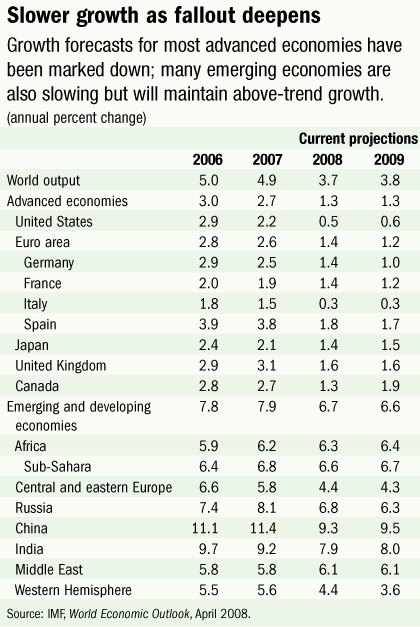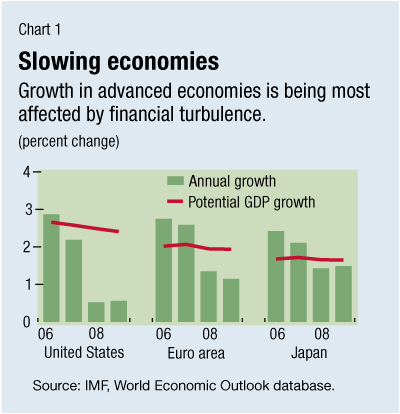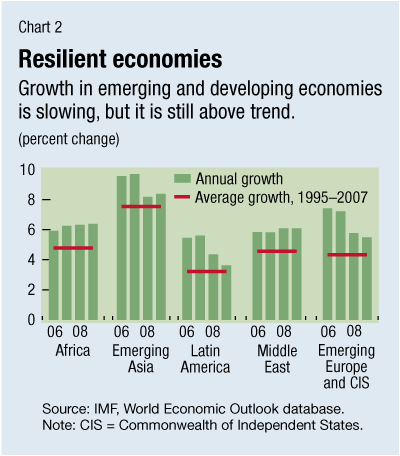World Economic Outlook
IMF Predicts Slower World Growth Amid Serious Market Crisis
By Subir Lall
IMF Research Department
April 9, 2008
- World growth will slow to 3.7 percent in 2008, in wake of financial crisis
- United States, other advanced economies lead slowdown
- Emerging economies are likely to weather storm better, but not insulated
Global growth will decelerate in 2008, led by a sharp slowdown in the United States, amid a housing correction and a financial crisis that has quickly spread from the U.S. subprime sector to core parts of the financial system, the IMF says in its latest World Economic Outlook.
Citing the unfolding financial market turmoil as the biggest downside risk to the global economy, the April 2008 report said the IMF expects world growth to slow to 3.7 percent in 2008—0.5 percentage point lower than what was forecast in the January 2008 World Economic Outlook Update.
Further, world growth would achieve little pickup in 2009, and there is a 25 percent chance that the global economy will record 3 percent or less growth in 2008 and 2009, equivalent to a global recession.
Balance of risks
Pointing to the balance of risks around the IMF's projections as lying "somewhat to the downside," IMF Chief Economist Simon Johnson said at a press conference on April 9 that "the principal downside risk comes from the possibility that financial strains could deepen."
And even though the "sentiment in financial markets has improved in recent weeks since the Federal Reserve's strong actions with regard to investment banks," he noted that "strains in markets can quickly become reinforcing, and the possibility of a negative spiral remains a possibility."
Johnson flagged continuing inflation worries, particularly in the wake of increasing commodity prices; large current account surpluses; and the "uneven pattern of exchange rate movement around the world" as the other downside risks.
On currency movements, he said the IMF's medium-term view was that "the dollar—in real effective terms—is now closer to its equlibrium value than at any time since the late 1990s, although it still remains somewhat on the strong side." The euro is on the strong side, the yen remains undervalued, and the Chinese renminbi "remains considerably or substantially undervalued," he added. [read Simon Johnson's Blog]
Gloomy prospects
Blaming the twin forces of deteriorating financial market conditions and the continuing correction in the U.S. housing market, the IMF predicts that the United States will slip into a "mild recession" in 2008, from which it will recover only modestly in 2009. This reflects the time it takes for financial institutions and households to resolve their balance sheet problems.
"Against the backdrop of weak financial market confidence, we expect consumption to remain weak in the coming quarters due to deteriorating labor market conditions, sluggish growth in disposable incomes, higher energy costs, and tighter constraints on household borrowing," Johnson said.
"Notwithstanding aggressive easing by the Federal Reserve and a timely fiscal stimulus package, signficant strains in housing and credit markets are likely to be protracted," he added. The IMF estimates that, from 2007 until end-2008, house prices in the United States would have fallen by about 14-20 percent
The report has marked down sharply its U.S. forecast for 2008 to 0.5 percent—1 percentage point lower than what was forecast in January 2008 and down from a 2.2 percent growth rate in 2007 (see table). On a fourth quarter to fourth quarter basis, U.S. output is projected to decline to 0.7 percent in 2008. The forecast for 2009 has been marked down to 0.6 percent on a year-on-year basis; the fourth quarter to fourth quarter estimate is 1.6 percent.

The ongoing financial crisis has led to persistent liquidity shortages, pressure on capital of banks and other financial institutions, increasing credit risks, and sharply falling prices of mortgage-related and other structured securities as well as of equities, the report said. The IMF issued a separate report on April 8 on global market conditions, ahead of the Spring Meetings in Washington of the IMF and the World Bank.
The worsening market conditions and the growth standstill in the United States have affected economic activity in other advanced economies, especially Western Europe where growth is expected to remain sluggish in 2008 and 2009, although Japan has remained more resilient to the downturn (see Chart 1). The slowdown in Western Europe is largely a result of financial strains and trade spillovers. The potential impact of softening house prices in many countries is a source of concern.
The euro area is now estimated to grow at 1.4 percent in 2008—compared with 2.6 percent in 2007—and the United Kingdom at 1.6 percent—compared with 3.1 percent in 2007.

Diverging, not decoupling
By contrast, the rapidly globalizing emerging economies have so far been less affected by financial market turbulence and have continued to grow at a rapid pace, led by India and China, although economic activity is beginning to moderate in some countries. Nevertheless, according to the IMF, growth across all emerging and developing regions will remain above trend (see Chart 2).
China and India--which grew at 11.4 percent and 9.2 percent in 2007, respectively—are projected to grow at 9.3 percent and 7.9 percent, respectively, in 2008. In response to a question about China, Johnson said that there would be "some impact on Chinese growth from the global slowdown." In this context, he called on the authorities to "allow for some exchange rate appreciation" of the renminbi.
He also pointed out that one way to rebalance the Chinese economy could be through tightening the monetary policy and easing on fiscal policy. "Because of China's exchange rate situation, there is a particular scope for dealing with the combination of circumstances [inflation concerns and slowing global growth] in a way in which it will both help them and help sustain global growth," he added.
Other emerging and developing economies, including in Africa and Latin America, are also expected to maintain robust growth rates. Emerging and developing economies have been more resilient during the current market turmoil than in previous episodes, although countries that had relied heavily on short-term cross-border borrowing or have stronger trade ties with the United States remain vulnerable to deleveraging.

Three broad factors are providing the momentum for growth in emerging and developing economies: first, strong productivity gains from the continuing global integration of these economies; second, better terms of trade for commodity producers as prices of commodities such as oil and other raw materials continue to soar; and, third, stronger institutions and macroeconomic policy frameworks.
Soaring commodities
The ongoing commodity price boom continued in early 2008, notwithstanding the market turmoil and slowing growth in major advanced economies. The IMF commodity price index rose by 44 percent from February 2007 to February 2008. Prices of many commodities—including crude oil, tin, nickel, soybeans, corn, and wheat—reached record highs in current U.S. dollar terms.
Strong demand from emerging economies has accounted for much of the increase in commodity consumption in recent years and has been the driving force in the price run-up. Biofuel-related demand has added to the demand for major food crops, especially corn.
At the same time, supply adjustments to higher prices have not kept up, especially for oil, leading to medium- to long-term low inventory levels in many markets. Also, financial trends—including the effective depreciation of the dollar, falling U.S. policy interest rates, and emergence of commodities as an alternative asset class—have all contributed to the soaring prices.
Rising inflation
Inflation continues to be a serious concern throughout the world. According to the IMF, headline inflation (that is, total inflation, including food and energy) has increased across the world, and core inflation (which excludes food and energy prices) is edging up.
Inflation is rising more markedly in many emerging and developing economies, driven by a combination of the continued buoyancy of food and energy prices, strong demand, and credit growth. Rising inflation in these countries also reflects the greater weight of energy and food in consumption baskets.
Policy challenges
The WEO underscores that in a multipolar world—with deepening financial and economic linkages across both advanced and developing economies—policy challenges need to be met broadly. That is, while recognizing differences in countries' circumstances, policy actions in a globalized world need to fully take into account cross-border interactions.
The advanced economies face the pressing policy challenges of addressing the financial turmoil and responding to downside risks to growth, while simultaneously keeping an eye on inflation and long-term concerns. Emerging and developing economies need to ensure that strong current growth does not lead to inflation buildup, while remaining alert to risks from growth slowdown in advanced economies.
In addition to monetary policy, fiscal policy could play a useful stabilizing role in the advanced economies in the event of a continuing downturn in economic activity. In case of a severe global downturn, providing fiscal stimulus across a broad group of countries could prove much more effective than isolated efforts by bolstering confidence and demand, given the inevitable cross-border leakages from added spending in open economies.
Publicar un comentario